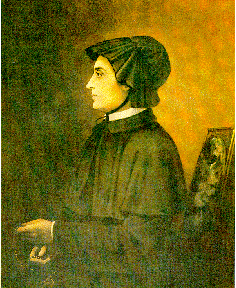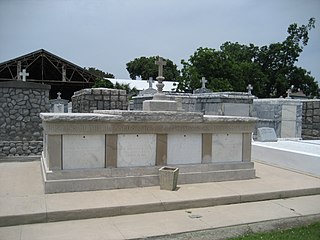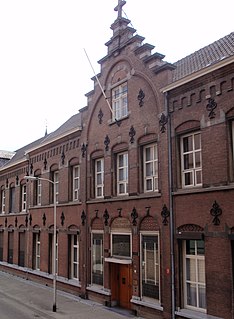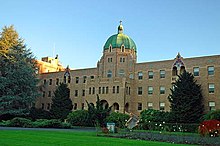The Franciscan Sisters of Christian Charity are a Congregation of Roman Catholic apostolic religious women. The congregation was founded in 1869 in Manitowoc, Wisconsin in the Roman Catholic Archdiocese of Milwaukee, later part of the Roman Catholic Diocese of Green Bay. The sisters have active apostolates in education, health care, spiritual direction, and other community ministries. As of 2021, there are 188 sisters in the community. The FSCC is a member of the Council of Major Superiors of Women Religious, an organization which represents women religious in the United States.

The Archdiocese of Portland in Oregon is an archdiocese of the Catholic Church in the Pacific Northwest region of the United States. It encompasses the western part of the state of Oregon, from the summit of the Cascades to the Pacific Ocean. The Archbishop of Portland serves as the Ordinary of the archdiocese and Metropolitan of the Ecclesiastical Province of Portland whose suffragan dioceses cover the entire three states of Oregon, Idaho, and Montana. The dioceses of the province include Baker, Boise (Idaho), Helena, and Great Falls-Billings.

The Sisters of St. Joseph, also known as the Congregation of the Sisters of St. Joseph and abbreviated C.S.J. or S.S.J., is a Roman Catholic religious congregation of women founded in Le Puy-en-Velay, France, in 1650. This Congregation, named for Saint Joseph, has approximately 14,000 members worldwide: about 7,000 in the United States; 2,000 in France; and are active in 50 other countries.

Mount Angel Abbey is a Roman Catholic monastery of Benedictine monks in the northwest United States, located in St. Benedict, Oregon. Northeast of Salem, it was established 140 years ago in 1882 from Engelberg Abbey, Switzerland. The abbey, located on the top of Mount Angel, a 485-foot-high butte (148 m), has its own post office separate from the city of Mt. Angel. As of 2021, the abbey is home to approximately 51 monks.

St. Mary's Cathedral of the Immaculate Conception is the seat of the Roman Catholic Archdiocese of Portland in Portland, Oregon, United States and serves Roman Catholics in western Oregon.

The Congregation of the Religious of the Virgin Mary is a Roman Catholic ecclesiastical community of pontifical right founded in Manila in 1684 by the Filipina Venerable Mother Ignacia del Espíritu Santo.

The Sisters of Charity of Saint Vincent de Paul of New York, most often known as the Sisters of Charity of New York, is a religious congregation of sisters in the Catholic Church whose primary missions are education and nursing and who are dedicated in particular to the service of the poor. The motherhouse is located at Mt. St. Vincent in the Riverdale section of the Bronx.

The Oblate Sisters of Providence (OSP) is a Roman Catholic women's religious institute, founded by Mother Mary Elizabeth Lange, OSP, and Rev. James Nicholas Joubert, SS in 1828 in Baltimore, Maryland for the education of girls of African descent. It was the first permanent community of Roman Catholic sisters of African descent in the United States. The Oblate Sisters were free women of color who sought to provide Baltimore's African American population with education and "a corps of teachers from its own ranks." The congregation is also a member of the Women of Providence in Collaboration.

The Sisters of the Blessed Sacrament (SBS) are a Catholic order of nuns in the United States. They were founded in 1891 by Saint Katharine Drexel as the Sisters of the Blessed Sacrament for Indians and Colored People.
The Presentation Sisters, officially the Sisters of the Presentation of the Blessed Virgin Mary, are a religious institute of Roman Catholic women founded in Cork, Ireland, by Venerable Nano Nagle in 1775. The Sisters of the congregation use the postnominal initials P.B.V.M.
The Benedictine Sisters of St. Walburg Monastery is a Roman Catholic congregation of women. whose motherhouse, St. Walburg Monastery, is located at Villa Madonna, in Villa Hills, Kentucky. It was founded in 1859 by three sisters of the Benedictine congregation of Mount St. Benedict Monastery in Erie, Pennsylvania, who came to Covington to teach the German-speaking children of St. Joseph's parish. They became an independent congregation in 1867. Villa Madonna Academy, a private, Roman Catholic K-12 school is an integral part of the sisters' ministry in Kentucky. Besides operating the Academy, the sisters taught in parish schools and staffed St. John's Orphanage.
Benedictine Sisters of Chicago is a Roman Catholic Benedictine congregation of women. It was founded in 1861 by three sisters of the Benedictine congregation of Mount St. Benedict Monastery in Erie, Pennsylvania, who came to Chicago to teach the German-speaking children of St. Joseph's parish. They became an independent congregation in 1872. St. Scholastica's Monastery in Rogers Park, Chicago is the Motherhouse. St. Scholastica Academy was an integral part of the sisters' ministry in Chicago.
The Monastery of Our Lady of Jordan was a Strict Observance Cistercian (Trappist) monastery in the community of Jordan in Linn County, Oregon, United States, founded in 1904 and lasting for about six years.

William Hickley Gross, C.Ss.R., was an American prelate of the Roman Catholic Church who was a member of the Congregation of the Most Holy Redeemer. He served as bishop of the Diocese of Savannah in Georgia (1873–1885) and \archbishop of the Archdiocese of Oregon City in Oregon (1885–1898).

Our Lady of Caysasay Academy (OLCA) is a Roman Catholic educational institution located in Taal, Batangas, Philippines.

Joseph Gregory Dwenger was the Roman Catholic Bishop of Fort Wayne (1872–1893).

The Sisters of Charity of Our Lady Mother of Mercy (SCMM) are a Roman Catholic congregation founded in the Netherlands in 1832 by Rev. Johannes Zwijsen, pastor of Tilburg, aided by Mary M. Leijsen, for the instruction of children and the betterment of people deprived of spiritual aid. The motherhouse is in Tilburg.
The Sisters of the Precious Blood is a Roman Catholic female religious order founded in 1845 in Steinerberg, Switzerland by Magdalene Weber and a number of young women from Baden.

The Sisters of the Precious Blood is a Roman Catholic female religious order founded in Grisons, Switzerland, in 1834 by Mother Maria Anna Brunner. Precious Blood Sisters form an active apostolic congregation with sisters currently serving in the United States, Chile and Guatemala. The congregation's mission statement reads: "Urged by the redeeming love of Jesus the Christ and rooted in Eucharistic prayer, we Sisters of the Precious Blood proclaim God's love by being a life-giving, reconciling presence in our fractured world." Members of the community are called to live out Precious Blood Spirituality regardless of their chosen ministry or daily work. Sisters have served in education, pastoral ministry, health care, social services and a variety of other fields.













